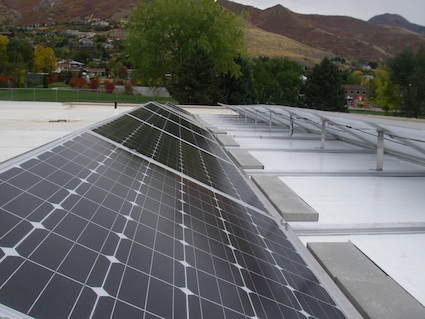Solar for Schools Hits Each District in Utah
 SALT LAKE CITY — As part of the Solar for Schools program, solar panels installations were planned at 73 schools across all 41 school districts in Utah.
SALT LAKE CITY — As part of the Solar for Schools program, solar panels installations were planned at 73 schools across all 41 school districts in Utah.
The program was designed and funded by the Utah State Energy Program and made possible by $3 million in federal funding under the American Recovery and Reinvestment Act. Johnson Controls, a building efficiency and local government solutions company, is managing the project by designing and installing the panels.
Johnson Controls is also providing a hands-on renewable energy curriculum for grades K-12 and teacher training, in partnership with the National Energy Foundation.
Hillside Middle School in Salt Lake City received twenty-two, 245 watt panels, which equals a 5.39 kW system. “The operating system produces enough energy to satisfy the annual needs of a typical computer lab,” said Greg Libecci, energy and resource manager, Salt Lake City School District.
The same PV system is also installed at the district’s Salt Lake Center for Science. Libecci said if budgets allow and Johnson Controls were to offer another system, he has another school identified and is ready to go.
“From a maintenance standpoint, there is not a lot to do,” said Libecci. “The snow melts off of it and a couple times a year we clean it off. The system should run without a hiccup and it has so far.”
The Salt Lake City School District serves approximately 24,000 students. Libecci emphasized the importance of raising awareness of efficiency and conservation in addition to renewals. He said the solar system is a nice initial introduction to renewable energy for the kids, parents and district.
“The curriculum piece allows students to compare schools and what amounts of power they’ve produced with a live data feed,” explains Bruce Munson, account manager, K-12, Local Government Solutions, Johnson Controls. “This program is about tying education to buildings, helping kids get interested and engaged in the math and sciences.”
Each solar panel is connected to a monitoring system so students can track live data from the installations and measure the effects of temperature and location on the energy output. They will be able to go online to a special website and compare their data with schools throughout the state. The website will be made live once all 73 schools’ solar installations are complete. Individual schools can then customize the curriculum for grade levels — elementary, middle, high school — and by subject matter area, e.g. math, science, language arts, social studies.
During most installations school is in session and the students are often unaware of the rooftop activity.
“One of the great things about the installation is that is does not interrupt the ongoing operation of the school,” said Charles McGinnis, energy solutions director, Johnson Controls. “You basically install these panels in a place that is appropriate for the right amount of sun, and you wire it into the building.”
Each 5.39 kW panel system, of mono-crystalline silicon solar modules and an inverter, occupies 61 feet by 13 feet of roof space.
Munson explained that the system is very modular in scale and scope and a 5 kW panel could be made into 10 kW very fast. “You can very easily upgrade or downsize them,” notes Munson.
With an average annual snowfall in the mountains near Salt Lake City of 500 inches, there has been no damage to the rooftop solar panels. “The snow melts off faster because they are black,” said Munson. “The snow may reduce production but it does not hurt the panels. They are glass and the snow slides off them. We have been able to maintain the integrity of the warranty system for all roofs.”
As for water damage, the chance of leaks is minimized by the fact that there is only one penetration per roof. “From a facilities perspective it is non intrusive,” said Mary-Jo Salzburg, program manger, marketing communications, energy solutions building efficiency at Johnson Controls. “With the ballasted system — there is only one roof penetration. We have been able to work with all roofing manufacturers to maintain their warranties.”
The panels sit approximately 16 inches above the roof. From a vandalism standpoint, Salzburg says that is preferred since they are not easily seen form the ground. “The panels are guaranteed to produce for 20 years,” said Salzburg. “Utah is spending its dollars wisely.”
More than 200 Utah teachers will attend a class this year sponsored by the National Energy Foundation. They will learn how solar, wind and geothermal energies work, with a special focus on the implications of renewable energy in Utah.
“To bring education to the students, it is not just about the facilities and it is not just about education. It is about the meshing of the two,” said Munson.
Salt Lake City School District’s Hillside Middle School was the first school to receive a solar array under Utah’s Solar for Schools program.
